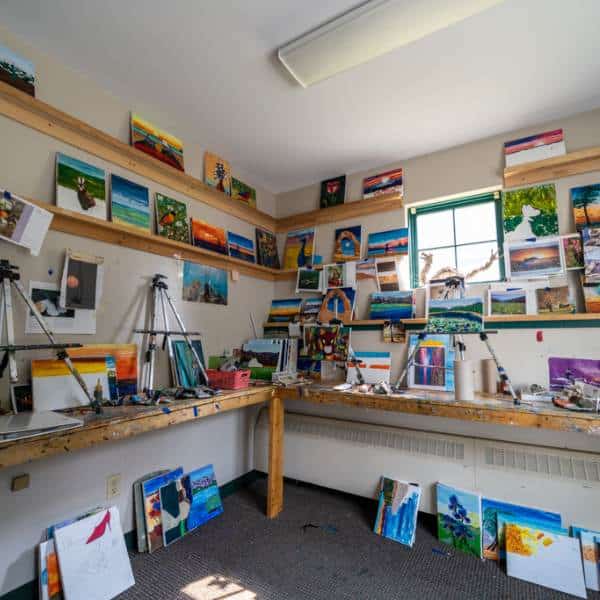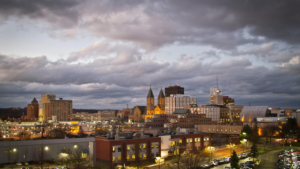At The Bluffs Addiction Campuses in Ohio, art therapy plays a crucial role in the holistic approach to addiction treatment. This innovative program offers patients a unique way to express themselves, manage emotions, and find healing through creativity. Let’s explore how The Bluffs is using art to transform lives and support long-term recovery.
A Multifaceted Approach to Art Therapy
Elisa, an art therapist at The Bluffs, explains the diverse approaches used in their art therapy sessions.
“I use art therapy very differently here,” she says. “We have guided projects, free expression, and everything in between.”
The program incorporates various techniques, including:
- Guided projects with specific themes
- Free-form artistic expression
- Breaking down complex images into manageable steps
- Creating art as a form of emotional processing
“Sometimes I’m like, go to your corner and do your art and just let them work through it,” Elisa explains. “Usually by the time that hour is up, they’re smiling and saying, ‘I feel so much better.'”
Specific Art Therapy Techniques
Drawing Faces of Addiction
One powerful technique used at The Bluffs involves patients drawing a face to represent their addiction. This exercise allows individuals to externalize their struggles and gain new perspectives on their recovery journey.
Breaking Down Complex Images
To help patients learn to manage overwhelming thoughts and tasks, Elisa uses an innovative approach.
“One of my favorites is breaking things down,” she says. “I’ll show them a picture of something. They get to pick out of like 10 different images and then they have to sit with that image and learn to break it down into manageable steps and recreate it.”
This technique not only improves artistic skills but also teaches valuable life skills for recovery.
“Nine times out of 10, by the next group, everybody is amazed at what they were able to do because they never thought they’d be able to accomplish it,” Elisa adds.
Managing Anxiety and Depression Through Art
For many patients at The Bluffs, traditional talk therapy can be challenging. Art therapy provides an alternative way to process emotions and experiences.
“I have had people that have been very anxious or depressed, and art is their way to make sense of the book going on in their head,” Elisa explains.
This non-verbal form of expression can be particularly helpful for individuals who struggle to articulate their feelings verbally. The act of creating art can provide a sense of calm and focus, offering relief from the overwhelming thoughts that often accompany anxiety and depression.
Diverse Mediums and Projects
The art therapy program at The Bluffs offers a wide range of mediums and projects to cater to different interests and skill levels. These include:
- Painting
- Drawing
- Crafting paracord bracelets
- Creating wooden treasure boxes
- Felt and velvet art
“We’ve been on a paracord bracelet kick lately,” Elisa shares.
This variety ensures that patients can find a form of artistic expression that resonates with them personally.
Therapeutic Benefits of Creating Art
Engaging in art therapy at The Bluffs offers numerous benefits for patients in recovery:
- Stress relief
- Improved self-expression
- Enhanced self-esteem
- Development of coping skills
- Mindfulness and focus
Elisa notes, “I get a lot of ‘this is the one hour where I feel like I’m truly myself’ because that creative piece has been brought out.”
Fostering Connections Through Peer Teaching
An unexpected benefit of the art therapy program is the way it encourages patients to support and teach one another.
Elisa observes, “It’s neat because then I teach, and then somebody else, like there will always be a patient that’s sitting and working with their peers and teaching them.”
This peer-to-peer interaction not only reinforces learning but also builds a sense of community and mutual support among patients.
Long-Term Impact of Art Therapy
The benefits of art therapy extend well beyond the treatment period at The Bluffs. Many alumni continue to practice artistic skills learned during their recovery. Elisa shares a heartwarming anecdote:
“One of our alumni at the birthday party today was showing me, ‘I’m still doing paracord,’ and showed me his new bracelet. His girlfriend was like, ‘He’s ordered two kits since he’s been home.'”
These ongoing creative practices serve as powerful tools for maintaining recovery and managing stress in everyday life.
The Ceiling Tile Project: A Unique Touch
One of the most distinctive features of the art therapy program at The Bluffs is the ceiling tile painting project. Patients have the opportunity to leave their mark by painting ceiling tiles, creating a lasting testament to their recovery journey.
“We’ve got one blank one waiting over here for somebody to paint,” Elisa mentions.
This project not only beautifies the space but also gives patients a sense of ownership and accomplishment.
Creating Connections Through Art
Art therapy at The Bluffs also provides a way for patients to maintain connections with loved ones during treatment.
Elisa explains, “A lot of people like to either be able to send something to their loved ones or their kids or make something to take home.”
These handmade gifts serve as tangible reminders of the progress made during treatment and the love shared between patients and their families.
Complementing Traditional Therapy
While art therapy is a powerful tool on its own, it’s essential to understand how it fits into the broader treatment approach at The Bluffs. Art therapy sessions complement traditional talk therapy and group sessions, offering a different avenue for self-expression and healing.
“It’s just a different approach than what we do in our talk therapy and in the other groups,” Elisa notes.
This multi-modal approach ensures that patients have various tools at their disposal for working through challenges and making progress in their recovery.
Positive Outcomes and Patient Feedback
The impact of art therapy on patients at The Bluffs has been overwhelmingly positive.
Elisa shares, “I’ve had a lot of people say, ‘Thank you for sparking that art side of me again. I had lost it, and now I can’t wait to go home and do art again.'”
These testimonials highlight how art therapy not only aids in recovery but also helps patients rediscover parts of themselves that may have been lost to addiction.
Conclusion: A Palette of Hope
Art therapy at The Bluffs Addiction Campuses offers a vibrant and effective approach to addiction recovery. By providing patients with the tools to express themselves creatively, manage emotions, and develop new skills, this program paints a brighter future for those on the journey to lasting sobriety.
If you or a loved one is struggling with addiction, consider exploring the innovative treatment options available at The Bluffs. Our comprehensive approach, including art therapy, can help you find healing, self-expression, and a renewed sense of purpose.
Take the first step towards a more colorful, addiction-free life. Call us today at 330-919-9228 to learn more about our art therapy program and other treatment options.








